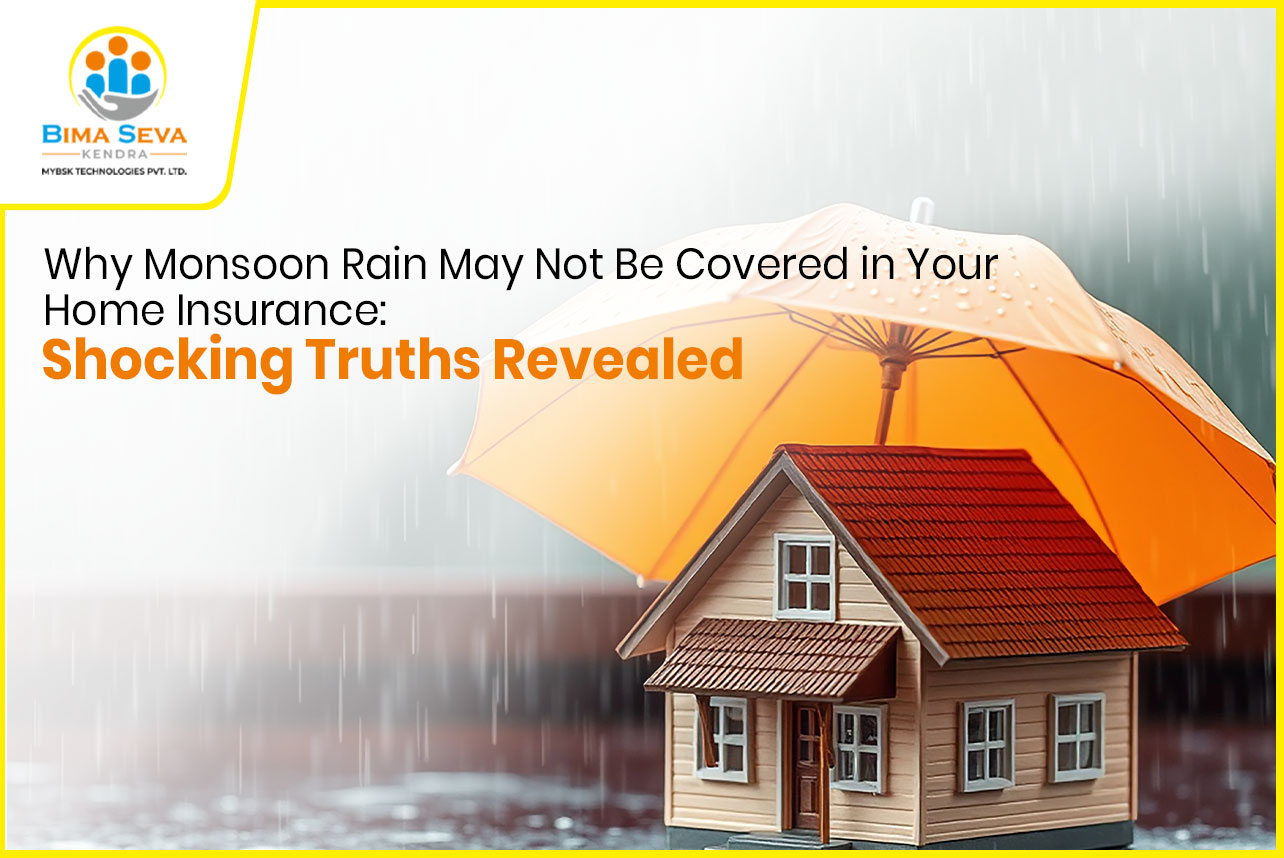
“ सेवा, सुरक्षा और समाधान ”

Why Monsoon Rain May Not Be Covered in Your Home Insurance: Shocking Truths Revealed
The rain that soaks your city could be the same rain that drains your savings.
If you’re under the impression that your home insurance has you covered this monsoon—think again.
Thousands of Indian homeowners discover only after the damage is done that their policies exclude the very things they assumed were basic: water damage, water seepage, and even floods caused by heavy rain.
Let’s pull the curtain back on what’s really protected in your policy—and what’s quietly excluded.
- The Illusion of “Comprehensive” Coverage
Home insurance policies often promise protection with broad words like “comprehensive” or “complete coverage.” But hidden beneath that promise are clauses and exclusions that can render your policy inadequate when monsoon rains hit.
Here’s the harsh truth: water damage is one of the most commonly misunderstood risks in Indian home insurance. That drain you accidentally left uncleaned while life got too busy? If the water damage is through any actions that could’ve been avoided, it is counted as neglect and can be the basis of an immediate claim rejection or insurance claim-related issues.
- What’s Typically Not Covered During Monsoons
Let’s break down some of the most common exclusions found in standard home insurance policies:
- Water Seepage from Walls or Floors
Slow, long-term seepage caused by rising groundwater or poor drainage? Almost always excluded. It’s considered a maintenance issue, not a sudden accidental loss.
- Roof Leaks
Heavy downpour that leads to leaking ceilings? Unless it causes structural collapse, you may find this is not covered. Most policies exclude gradual leaks, calling them wear-and-tear thus resulting in claim rejections.
- Negligence and Pre-Existing Issues
If the damage is a result of the homeowner's failure to maintain their property, such as not sealing windows properly or neglecting clogged drains, the insurer may deny the claim. Also if skipped waterproofing layers cause water damage and cracks, insurance won't step in. That’s viewed as a construction fault, not an insurable risk. Any later damage caused by these issues too may not be covered.
- Natural Disasters Without Add-Ons
Flooding due to heavy rains? That’s not always included unless you’ve specifically opted for a natural calamity rider. Many basic home policies exclude floods, landslides, and water logging unless explicitly added.
- Why These Exclusions Exist
Insurers separate accidental, sudden losses from progressive, preventable damage. The logic is:
“We insure risk, not neglect.”
Water seepage due to ignored cracks, lack of maintenance, or long-term dampness doesn’t qualify as an “accident” in policy language.
It may seem unfair, but from the insurer’s standpoint, it’s predictable—and therefore, uninsurable under base coverage.
- A Real Example: The ₹3 Lakh Mistake
Meet Meera, a homeowner in Navi Mumbai. Before monsoon season, she noticed faint water stains forming near the ceiling corners. She assumed it was humidity or maybe a one-off issue. Life got busy, the marks faded, and she forgot about it.
Then came the downpour.
Heavy rain over several days caused water to seep through her roof. Her ceiling sagged, wall paint peeled, wardrobes warped, and electrical fittings began short-circuiting. She filed an insurance claim hoping for quick claim settlement.
The verdict? Claim rejection.
Why? The insurer pointed to a clause excluding “damage resulting from pre-existing structural issues or gradual water ingress.”
In their view, Meera’s earlier stains—though minor—meant the roof had pre-existing vulnerability. The leak wasn’t sudden, it was progressive wear and tear, and her lack of repair was deemed unintentional neglect.
Understandable? Yes. Forgivable? Not by the policy.
No rider. No reimbursement. Just heartbreak—and a ₹3 lakh repair bill.
5. So, What Should You Do?
A false sense of security is the most expensive mistake you can make during monsoon season. Here’s how to protect yourself from claim rejection and unexpected losses:
- Read Your Exclusions Thoroughly
Don’t just skim. Look for phrases like:
-
- “Does not cover damage due to water seepage”
-
- “Excludes maintenance-related issues”
-
- “Flood coverage available only with endorsement”
- Add Natural Calamity Riders
Floods, landslides, and storm surges are rarely covered under base plans. If your home is in a high-risk area, these riders are essential.
- Get Waterproofing & Repairs Done Proactively
Insurance won't pay for neglect. But proof of preventive maintenance strengthens your case in borderline claims.
- Consult a Subject Matter Expert
Even well-read policyholders miss nuanced exclusions. Working with someone who understands claim rejection trends and policy interpretation can make all the difference between approval and denial.
They’ll help you:
-
- Identify coverage gaps
-
- Recommend high-risk add-ons
-
- Prepare for monsoon proactively
The Language of Insurance Isn’t Built for the laymen.
And that’s the problem.
While your damage may be real, insurers care more about what’s “defined” than what’s
“felt.” That’s why homeowners must shift from assuming coverage to demanding clarity.
Remember: it’s not the rain that causes financial harm—it’s not knowing whether you’re covered when it pours.
Final Thoughts
Monsoon rain has a way of exposing more than just cracks in our walls. It reveals the gaps in our protection, the fine print we never read, and the real cost of vague promises.
So this season, don’t just hope your insurance will step in—know it will.
Ask the hard questions. Add the right riders. And if needed, get expert eyes on your policy before the skies open up.
Because when it comes to monsoon damage, the truth is in the exclusions—and they don’t care how shocking it feels once it’s too late.
© 2025 MYBSK All Rights Reserved. Designed By SKALY INFOTECH PVT.LTD.
